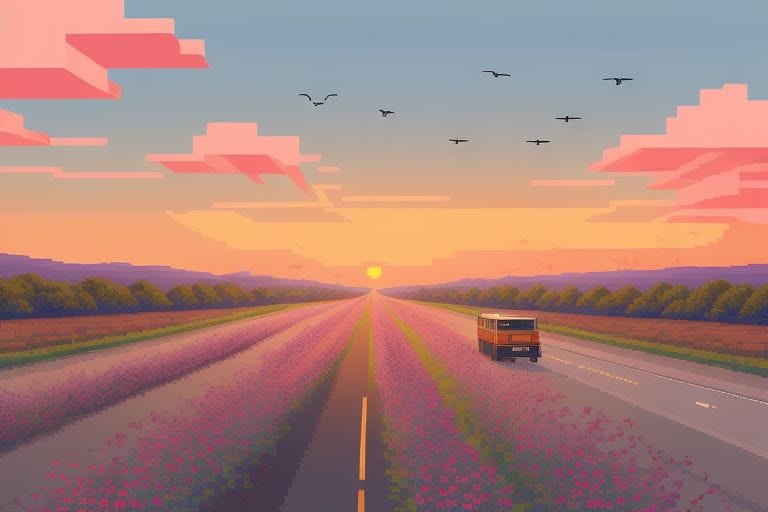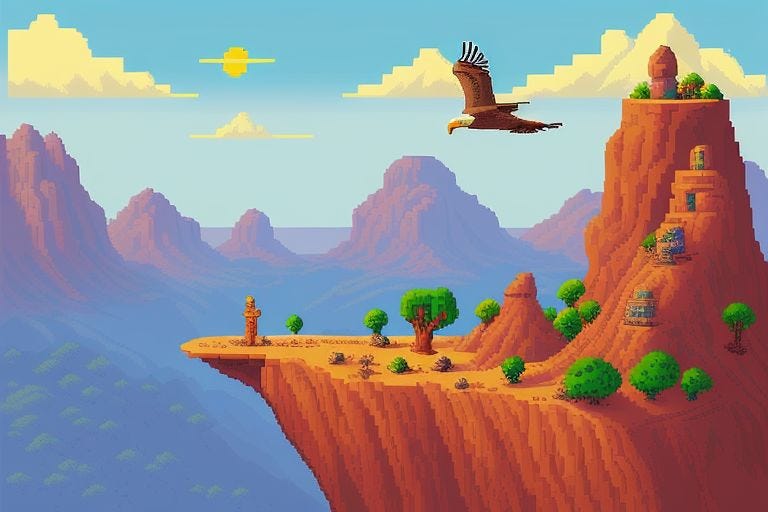Nkata Kwsi: Migration as Our Essence
Keynote Address for the People's Literary Festival, Corpus Christi, TX February 2024.
Let’s open with a small bit of Unami Lenape language and thought. Essences are important when looking for common spaces in literature, in poetry. The spirit of this talk today, Nkata Kwsi, I need to move. And I say that it is the spirit of the talk today because all things are done in spirit. These simple two words are poignant words for anyone that understands even the smallest portions of the Lenape experience. We, as a nation, were among the first to greet the newcomers that had arrived Osakame, from across the water. And sure, our elders and our speakers of visions, they had known that the strangers would arrive. This was spoken about in the Xinkwikaon, the Big House, and we had enough time, they thought, to prepare for the arrival. We also knew that many of these new arrivals would be like foam on water. Because of this we told many of relations to move inland and a large number of us stayed. That went poorly for us, as Lenape. And the need to move began, or became apparent for us as a people. But this is a talk about literature, about writing, about recording uniquely human experiences. If this is the thought behind our journey, then let’s begin to move. Let’s feed this need and let’s begin this movement of ours.
We all begin somewhere. This is the way that time and existence works for all of us. Rooted partially in thought and partially in physical space. We are creatures of at least dual existences. Our Unami Lenape word for creator, Kishelëmùkònk, means the one who thought the universe into existence. And all of creation are reflections of that thought. Places where we are born host this quickening of thought, or spirit, and pull us into being. And in doing so the physical spaces we inhabit shape us. For me personally, this place was the lands of the Three-Fires Confederacy. Along the south shore of Waawiiyaatanong, the narrows between Great Lakes. The river narrows, that various points along the shore and low-lying earth, have long been temporary homes to passing peoples of many nations. Portions of them all have stayed. Portions of them have left. Odawa, Huron, Wyandot, Haudenosaunee. Pottawatomi, French, English, Polish, Black, Jew, Palestinian, Yemeni, to name but a few. And what came out of that arriving and mixing and leaving has become a culture of highways and automobiles, a religion of speed and movement. And this has been reflected in the poetry emerging from this place. Work that has long informed my process as an artist and a scholar.
I am haunted by a particular poem by former US poet laureate Philip Levine. He is another man raised along the narrow and bent shores of our river strait. The poem is Belle Isle, 1949. In the fairly well-known poem, Levine’s speaker escapes from the drudgery of his young life in assembly line Detroit. Levine’s narrator escapes to the popular Belle Isle beach in the off-season. He does so by swimming out into the miasma of the river with a Polish high school girl “he’d never seen before.” The poem begins with we and ends with “back where we came from.” Shared ideals of movement, shared between individuals. Belle Isle is Detroit’s version of New York’s Central Park. The river has long been our region’s first highway. And still is today with the constant stream of lake freighters, pleasure craft, and coast guard ships. And in the poem the collective cold weather skinny dip into the river, he undergoes the sort of metamorphosis that begins his journey from this point. Levine and his speakers move from the cold hard realities of Midwestern industrial heartlands to the sweeping warm weather vistas of California and the American west. Levine’s dream. Perhaps the spirit of restless river affects all those that draw from the lands its feeds. The land determines everything. The places we inhabit push into motion. Nkata Kwsi.
While some left, others came and stayed. But still their dreams of perpetual motion continued. And those dreams became new work. Eugene McNamara was also one of those arrivals. He came to the south shore from Illinois in the 1960s and established what is widely regarded as the literary culture of Windsor. But unlike Levine, he never left his adoptive home of Windsor. At least permanently. And his body of work speaks to this. Poems about the border cities, memories of his Midwestern home, echoes of places that one would call decidedly rooted. And all seemingly are topics that tended to lay roots and resist notions of movement. Yet within even the most “settled” of McNamara’s poems you can hear the whispers of that need to move. Take “The Moving Light” for example.
The Moving Light by Eugene McNamara
Morning shadows of spare trees
shake on the sidewalk ahead of you
as you go over the shadows up
there a girl waits at the corner
watching down the still street
no bus and someone else is getting
a ticket for a moving violation and
others pass as you go on still the
shadowed ground as you pass through
other shadows thinking what when
where and then look up at the bent
trees and contrails high beyond
going someplace remember yes a girl
playing the flute her lips tasting
the music her eyes on something
years away her sister waiting well
its nothing to you not your problem
here on this birdsong morning you
take the air under the blessing
branches moving on moving away.
Much like Levine’s work, the familiar and the static aspects of life in the border cities is apparent and dominating in McNamara. And although he never was taken to “moving away,” the anxiety of the need and want to move is apparent. The city scape is in constant motion along with the narrator. As we wait, we wait anxiously and watch an unsettled world move around us. We are born from the spirit of the land. And McNamara in his much more subtle ways recognizes this.
Levine and McNamara have long held a special place for me as a writer. Their work draws from the land we share. And as such we share in the spirit of the place. And the place in turn feeds our words and our stories. The three of us, and needless to say many many other artists and writers of note in our homelands, are born to the same earth and live with the same anxieties. Motion that landed our ancestors into new homelands rests within us. An essence that speaks partially to restlessness and partially to the hard land beneath us. For me this need to move lies in my ancestral lines. As I stated earlier, my people once called the lands around New Jersey, Pennsylvania, and New York our homelands. Lenapehoking. They did so for millennia, time immemorial, until the great flight happened. And we landed in disparate places of Turtle Island such as Oklahoma, Wisconsin, and Ontario. But we had long been travelers, given more to life outside of large communities. Individuals brought stories back of these distant places, experiences, and visions. We built ceremonies around sharing their stories. Our movement made our people whole and as the land was stolen away from us, the stories and ceremonies that arose from that movement are what bound us together. We must move to survive. We must move to endure.
And our stories followed. They transformed alongside us. My family still speaks of ancestral lands along Opek Sipu in modern day Indiana. A great deal of my relations long for Manhattan, others for the foothills along Weli Sipu, the Ohio River. Our motion matters. John Hill is perhaps the most infamous historical traveler for the Lenape. A man who wandered west, before America crossed the Valley of the Flowers on the edges of Apsáalooke territories, his individual story is one of the few that we have. His stories were collected by the Lenape scholar Richard C. Adams as he built the early collections for the Newbury Library in Chicago. They come to us not in the lyric lines of poetry, more the cursive of early prose in the Americas, but rather in the drawings Hill produced in his lifetime. Drawings made on the move, crisscrossing the lands that would become Montana, Idaho, and California. Hill’s exploits, with his Nez-Perce relations, were primarily of the survival kind. Edith Wharton may have referred to them as adventure stories in her three main categories of literature. And in this adventure stories, they fought this many Cheyenne or this many enemies that were trying to end them. Hero boy descends at one point and saves Hill and his fellow travelers in fight with Mexican soldiers. They “read” as familiars in the American cannon. There is little doubt that is the continuum of Indigenous literatures of Turtle Island, that Hill’s autobiography, act in the similar vein to Dresser’s Hoosier Holiday, Kerouac’s On the Road, Steinbeck’s Grapes of Wrath. What we get out of this is that the need to move is inherent in the rooted literature of the Americas. The need to move, nkata kwsi, is clear in Hill’s record of his life.
And if John Hill provided that first major portion of movement in our written or literary record, at least for us Lenape, then what of more contemporary writers in the Indigenous tradition? In many ways, my internship in Indigenous writing and scholarship begins with the great Nish writer and scholar Gerald Vizenor. While I first encountered his work as a theorist, some years later in my big sky and open highway stay in Montana, I discovered Vizenor’s work in haiku. Much like John Hill, Vizenor had voyaged well out from the homelands and found himself stationed in southern Japan on a tour with the US military. And the place fed him in a deeper spiritual and literary manner. In him nurtured an Indigenous type of haiku (he produced multiple books of them). His journey had fomented a new hybrid, one that has helped to shape. Operating in a similar fashion to the crisp images of scalped warriors, wild horses, and free-flowing creeks of Hill’s work, with the adherence to concrete imagery and the physical world around them, the traditional Japanese forms of poetry spoke to Indigenous land-rooted culture. As I’ve heard from my elders on countless occasions, the land determines everything. Land that can only be understood by walking upon it. So, Vizenor takes those Japanese forms and what we get are pieces like this one.
March in North Dakota by Gerald Vizenor the whole moon burns behind jamestown seven wings of geese light the thin ice asian sun bleeds on the interstate pressed flowers tremble in the prairie stubble pace on the mirror my fingerprints blot the past.
Although using those forms, he learned in his travels, poems like this one illustrate the focused sensory-driven movement on the land. Vizenor’s inherent need to move, a willingness to hear and act witness to that movement, to embody its nature are all too visible in his work.
Where Vizenor and Hill took their inherent need to move to larger and often more distant vistas, we can and must see the same motion inherent in our nature in a more physically rooted writer. Somewhat akin to McNamara, Acoma Pueblo writer and scholar Simon Ortiz embraces the vastness of land and space around his Pueblo homelands. The focus of his work is on the homelands. And with his words he carries us around the lands that he draws spirit from. In “Spreading Wings on Wind” he begins with “I must remember/that I am only one part/ among many parts,/not a singular eagle/or one mountain. I am/a transparent breathing./ Below are dark lines of stone,/fluff of trees, mountains/ and the Earth’s People – all of it,/ the Feather in a prayer.” And this is it, the view of opalaine, ahas, màxkalaniat, as they soar above the slower turning earth. In motion we see clearly, like the eyes of the great hunter. Our need to move is a need to see, to touch, to stoke the sparks of beauty of creation. And stoke those sparks to embers as if our vision and our words become that “Feather in a prayer.” Coaxing smoke and blessings from smudge medicine. Our words, ourselves, our very beings tied to rising smoke, spinning freely in the air.
All of this to offer an important message in our times. We are all people of movement. We are artificers of our own borders. We often wrongly ascribe power to others for setting borders. Borders are not natural on this continent. The villages at Waawiiyaatanong, like the villages along those sacred waters at Opek Sipu, were only Odawa or Lenape in name. The homes were filled with people of many nations. And those lives were filled with the stories of the journeys that led them there. If we accept that motion is the natural state of things, an essence to contented life on must aim to lead, than we must accept that we be long surrounded by people of many nations. Because they too aim to move and to connect and on occasion to settle, if only temporarily. The only natural place for a writer, for a person, is the place that their own soul and will attaches them to. A place beyond all too human borders.
I can think of no better writer and inspiration to leave you with today than Joy Harjo. Another of America’s greatest poets laureate, Harjo is of Creek descent, and outside of her critically important literary work, she is an exceptional musician. Harjo captures one of our Turtle Island’s most sacred citizens essence in her “Eagle Poem.” Opalaine, in Lenape, Bald Eagle is English, is the most sacred of creation because they fly highest, closest to Creator, twelve heavens above. Thet discern the nature of his thoughts and deliver messages and gifts to us. And they carry our messages back through the twelve heavens to Creator. Opalaine, like us, is given to move. Let’s begin our collective movement today. Nkata Kwis. Bring that movement to the work we do, understand how none of us are given to rest. And that the voyage, the motion, is the point. It is everything.
Eagle Poem by Joy Harjo To pray you open your whole self To sky, to earth, to sun, to moon. To one whole voice that is you. And know there is more That you can’t see, can’t hear Can’t know except in moments Steadily growing, and in languages That aren’t always sound but other Circles of motion. Like eagle that Sunday morning Over Salt River. Circled in blue sky in wind, swept our hearts clean With sacred wings. We see you, see ourselves and know That we must take the utmost care And kindness in all things. Breathe in, knowing we are made of All this, and breathe, knowing We are truly blessed because we Were born, and die soon, within a True circle of motion, Like eagle rounding out the mourning Inside us We pray that it will be done In beauty In beauty.
Acknowledgments: I would like to kindly thank Dr. Scott Obernessor and Sarah K Lenz for the invite to beautiful Corpus Chirsti, TX and for introducing me to a wonderful literary community there.









